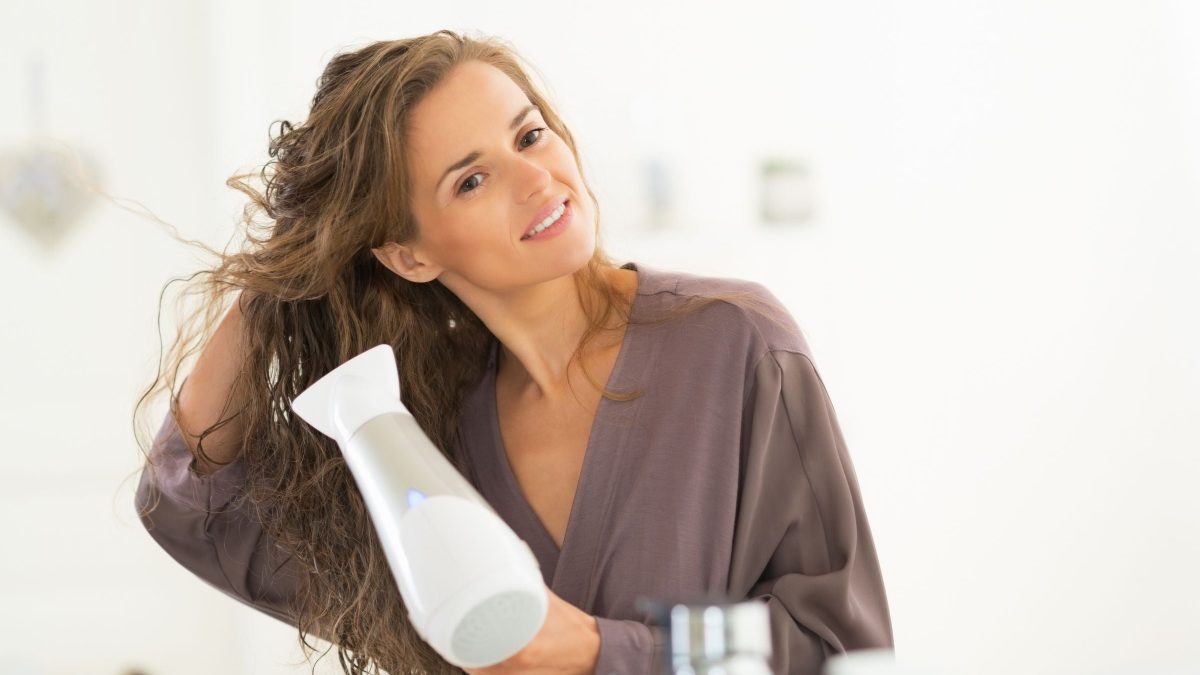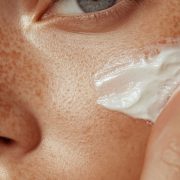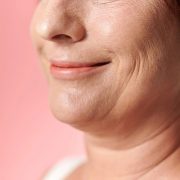Unlock the Secret to Healthier Locks: Navigating the Great Hair Drying Debate
Posted on October 4, 2024 Written by: 100% PURE®

Anything that is wet can have a degree of vulnerability to it. Just as there are bright yellow signs that warn of the dangers of wet floors, wet hair should come with a caution sign that it’s most vulnerable when it’s wet. So, the great question is, “to dry or not to dry, that is the question – and debate?!
When it comes to blow drying versus air drying your strands, each has its own tangle of confusing and conflicting advice on drying methods. While blow drying might seem like a straightforward method, it can often lead to frizz, breakage, and split ends. Wet hair, on the other strand, is more fragile than dry hair, so any rough handling of it could lead to breakage. Managing wet hair is also a daily challenge.
Is one drying method a cut above the rest? Let’s comb through the benefits and potential drawbacks of blow drying and air drying. From root to tip, we’re covering what method is better for your tresses and proper drying techniques – plus top tips for finding the best and safest way to dry your hair.
Join us in the great strand (Shakespearean) soliloquy “to dry or not to dry” to unlock the secret to healthier locks!
Understanding Hair Drying Science
For anyone aiming to maintain healthy, strong hair, understanding its vulnerability when it’s wet and how hair responds to water is crucial – and it all starts with the shower. Is there anything better than starting your morning with a hot shower? Nothing beats the feeling of turning on the tap and feeling that steaming water cascade down your skin; maybe you pamper yourself with a hair mask, a skin scrub, or even your favorite body wash.
You step out of your shower – try not to slip – feeling refreshed, renewed, and ready for hair care as part of your routine. You go in to quickly towel-dry strands and let au naturel air do its thing or skip altogether for a quick blow-dry. It’s going to be a great day.
However, could your hair-drying method of choice which you do nearly every day, and perhaps enjoy, be causing damage, split ends or breakage to your hair? To get to the root of the tress mess, let’s cover the hair’s structure and how it responds to water.
When hair is soaking wet, it undergoes a physical change that makes it more elastic and fragile than its dry state. This increased elasticity means that the hair shaft can stretch more easily. This extra flexibility comes from the bonds within these proteins, which briefly loosen when in contact with water and gain more potential to stretch. Protein plays a vital role in hair health – as hair is primarily made up of a protein called keratin – and hair’s structure and water absorption. Keratin is responsible for providing structure, strength, and elasticity to hair strands. When hair is damaged, the protein in the hair shaft can break down, causing hair to become weak, brittle, and prone to breakage.
The cuticle, which is the outer layer of the hair shaft, can also swell and lift when the hair is wet. This allows moisture to penetrate the hair shaft; the degree to which the cuticle opens and closes determines the hair’s “porosity” and its ability to absorb and retain water, with tightly closed cuticles making it harder for water to enter (low porosity) while loosely spaced cuticles allow for easier absorption (high porosity). With the cuticle swelling and lifting when the hair is wet, it exposes the inner layers to potential harm and makes the strands more prone to breakage and split ends.
As wet hair is air-drying, it goes through a process of evaporation. While it’s a natural process, leaving hair wet for extended periods can be damaging due to the increased fragility of wet hair, making it important to dry your hair properly after washing to avoid breakage and damage. More about that topic is below!
So, what is the impact of blow-drying on hair? Heat damage from hair dryers is a major culprit of the health of your strands. When hair is dried with a hair dryer, the water in the hair changes from a liquid to a gas without boiling. This is because the heat from the dryer speeds up the evaporation process, and warm air can hold more moisture than cool air. When you blast your hair at high temperatures, it can break down the protein bonds and weaken the hair shaft, leading to breakage and split ends or causing hair to become weak, brittle, frizzy, and dry. Prolonged heat exposure can break the keratin proteins in hair, causing them to lose strength and elasticity.
Hair damage is common and it often . Rough towel drying is another common mistake. Vigorously rubbing your hair with a towel can create friction, causing frizz and breakage. Environmental factors like sun exposure, pollution, and humidity also play a role in damaging your hair. Wet hair becomes more susceptible to damage from mechanical actions such as brushing, combing, or even the simple act of rubbing it with a towel. This vulnerability is why adopting gentle handling and drying practices during and immediately after hair washing is paramount.

Exploring Air Drying
Just like hair washing is essential for hair (and scalp) health, moisturizing is key to maintaining a healthy mane. Aside from improper hair care routines and heating tools, chemical treatments like coloring and relaxing can also damage your hair’s cuticle, making it prone to dryness.
Environmental factors such as sun exposure, wind, and pollution can deplete your hair’s moisture levels. Additionally, harsh shampoos, frequent washing, and insufficient conditioning can disrupt the natural balance of oils and moisture in your hair, leading to dryness.
Proper hydration and moisturization can prevent breakage, , and improve your hair’s overall health. That’s what makes techniques such as air drying instead of blow-drying have a ‘lock’ up in terms of retaining moisture and overall hair health. Air drying your hair can have many benefits, including:
Benefits of air drying:
Reduced heat damage
Air drying minimizes heat damage that can occur when using a hair dryer, which can strip your hair of moisture and cause breakage.
Enhanced natural texture
Air drying allows your hair to dry naturally, which can help retain moisture prevent breakage, , and optimize your hair’s texture.
Maintains color
Air drying can help maintain the vibrancy of color-treated hair.
Prevents scalp issues
Air drying can help prevent scalp that can be brought on by exposure to heat blowing. This can be helpful for people with dandruff or scalp sensitivity.
Saves time and money
Air drying can save you time and money, especially if you have thick or long hair that takes a long time to blow dry or requires a lot of products like heat treatments.
Reduces energy consumption
Air drying is a natural process that doesn’t use electricity, so it can help you reduce your energy consumption.
However, air drying can also have some drawbacks, including:
Extended moisture exposure
Leaving hair wet for extended periods can be damaging to its proteins and cuticle due to the increased fragility of wet hair. Moisture is a key factor in healthy strands, and overloading hair water can leave it limp, lifeless, and weighed down.
Frizz
Some hair types may become frizzier when air dried, as they don’t have the smoothing effect of a blow dryer and/or use a styling hair brush.
Risk of bacterial growth in humid conditions
Hair that stays wet or damp for a long time can attract bacteria and fungi, especially in humid conditions. Sleeping with wet hair also runs the risk of this because it creates a warm, damp environment that encourages the growth of bacteria and fungi. This can lead to scalp problems like dandruff or seborrheic dermatitis.
The Time vs. Hair Health Battle
Saving time versus saving hair health is a bit like the phrase, “quantity over quality”, where the great hair drying battle may be hung up on whether it’s better to prioritize the quantity or amount of time saved versus the quality of hair and its potential damage from air drying or blowing it. Let’s check out some time versus hair health perks.
The desire for quick, convenient hair drying:
Many of us may have the intention to want to carve out time to air-dry our locks. The reality is between busy work family schedules, and daily responsibilities, we really don’t have enough hours in the day to get everything done. That makes blow-drying hair more ideal. This hair-drying method takes less time than air drying, making it quick and convenient – and perfect for busy people. If you gently towel dry your hair before whipping out your hair dryer, you can quickly dry your hair in the morning before work or in the evening before bed.
Concern about potential heat damage:
Let’s revisit the time and convenience appeal of blow-drying strands. When you blast hot air onto wet hair, small bubbles form inside the shafts. This weakens your hair, making it more prone to dryness and brittleness. In other words, hello tangles, breakage, and dull locks. Moreover, using a hair dryer at those high temperatures sucks the moisture from your hair, leaving it prone to frizz. Hair loses its natural shine because the cuticles, which give hair its sheen, have been damaged. Heat damage is a factor in hot showers, too – so keep it lukewarm for the sake of your hair.
Balancing styling needs with hair health:
When you know how to blow dry hair and it’s a staple in your styling routine, you could get a little overzealous with your styling brushes, heating tools, and hair care products – all for the sake of sassy styles! But it’s important to balance your styling needs with the health of your hair so you don’t end up with a meek mane. This may include using heat tools in moderation, and if you use heat styling tools, use them on a low setting to minimize heat damage. Avoid products with harsh chemicals, sulfates, and alcohol, which can strip your hair of natural oils. Instead, use natural and organic hair care products.
The Case for Blow Drying
Are you looking for a quick and effective way to elevate your hairstyle? Blow drying opens a variety of styling options that go beyond just drying your locks. Whether you want to straighten, curl, or add volume, the dryer is a foundational tool in achieving these looks. Embrace the power of a good blow dry, from achieving voluminous, salon-worthy looks at home to reducing frizz and prepping your hair for the perfect style. Blow drying can have many potential benefits of controlled heat application, including:
Speed and convenience
Blow drying is a quick way to dry your hair. Moving from wet to styled hair rapidly, it’s perfect for those with a busy lifestyle needing quick results.
Styling versatility
Blow drying can give you a variety of styling options including volume, smoothness, and straightness. Whether you want to straighten, curl, or add volume, the dryer is a foundational tool in achieving these looks.
Preparation
Blow drying can prepare your hair for further styling with other products or tools. A good blow dry sets the stage for further styling with other tools or products. Dry, prepped hair is easier to work with, making it more receptive to hairstyles that follow.
Scalp health
Blow drying can help get rid of excess moisture on your scalp, which can prevent fungus and bacteria from festering.
Hair cuticle
Blow drying at an angle away from your scalp can help re-seal wet cuticles, making your hair shinier and smoother.
Controlled styling
With various heat settings and attachments, blow drying provides more control over how you style your hair, allowing for precision and customization in your daily routine.

The Hair Drying Solution: Finding the Right Balance
Many common drying methods can cause unnecessary damage, leading to frizz, breakage, and split ends. By adopting gentle and effective drying techniques, you can protect your hair from harm and keep it looking its best. Here are the key steps to drying your strands without damage, along with some useful tips to ensure you get the best results and the right balance for healthy, happy hair.
Optimal air drying techniques:
Gentle towel-drying methods
Avoid rubbing your hair. When your hair is wet, it is in its most fragile state. At this point, rubbing it vigorously with a towel can cause long-term and cause your hair to fall out. Excessive rubbing with a towel can also lead to major frizz and split ends.
Using microfiber towels or T-shirts
Using a microfiber towel or a soft t-shirt to dry your hair can make a significant difference. These materials are much gentler on your hair compared to regular towels, which can cause friction and damage. Microfiber towels and t-shirts gently absorb excess water without roughing up the hair cuticle.
Tips: Wrap your hair in a microfiber towel or t-shirt to reduce frizz and breakage. Avoid rubbing your hair; instead, pat it gently to soak up the moisture.
Applying leave-in products for protection and styling
Using a on your hair before blow-drying can help reduce damage to your hair. You also need a leave-in conditioner to protect your hair if you use a straightener or curling iron. The leave-in treatment will not only help protect your strands from heat damage, but it will also create that smooth, shiny style you covet.
Healthy blow-drying practices:
Using heat-protectant products
Applying a heat protectant is essential before using any heat-styling tools. is a great option as it shields your hair from the damaging effects of heat while adding smoothness and shine.
Tips: Apply the serum evenly on damp hair before blow-drying, straightening, or curling. This will help protect your hair from high temperatures and reduce the risk of damage.
Proper temperature settings and distance
The thinner/ shorter your hair, the lower the heat setting should be. Fine and light hair stay on the lowest end of the spectrum while thick, long hair can go much higher depending on the style.
Directional drying techniques for reduced damage
When you need to use a blow dryer, opting for one with a diffuser attachment can help distribute heat more evenly and reduce frizz and damage. This ensures that your hair dries more gently and evenly, and it maintains its natural texture.
Tips: Use the blow dryer on a low heat setting and keep it at a distance from your hair to avoid direct heat exposure. The diffuser will help spread the heat evenly and minimize damage.
Achieving Healthy, Well-Dried Hair
One size certainly does not fit all in the world of locks. Have you ever gone through seemingly the right prep, step, and pep for a hairstyle only to have the result flopping faster than curled hair in humidity? When we say, it’s not you – it is, really, you – or your hair type. Different hair types can respond differently to heat and airflow. Let’s cover hair types, drying techniques, and how to find the right balance for beautifully, well-dried-styled hair that lasts.
Customizing drying methods to hair type and lifestyle:
Whether your mane cascades in a wave, bounces with curls, or oozes a sleek straightness, understanding your hair type and customizing the drying method appropriate for it is the key to unlocking its true potential.
Fine / Straight hair texture:
Characteristics: Fine hair strands are smaller in diameter, often giving a silky and delicate appearance. Fine hair can be prone to limpness and lack of volume, so the goal is to add body and fullness without weighing it down.
Drying Method: Blow-dry in sections, lifting the hair at the roots and directing the airflow upwards. Use a lower heat setting to avoid damaging the delicate strands.
Wavy hair texture:
Wavy hair needs definition and control without losing its natural texture.
Drying Method: Blow-dry on a low to medium heat setting, scrunching the hair gently with your hands to enhance waves.
Curly hair texture:
Curly hair requires careful handling to preserve the curl pattern and prevent frizz.
Drying Method: Dry the hair in a low heat setting, gently scrunching the curls with your hands. Avoid touching the hair too much to prevent frizz.
Coarse / Coily hair texture:
Coarse, coily hair needs moisture and gentle handling to maintain its texture and prevent breakage.
Drying Method: Blow-dry on a low heat setting, using the diffuser to gently stretch and define coils. Take your time to ensure even drying without causing damage.
Thick / Straight hair texture:
Characteristics: Thick hair boasts a larger diameter, giving a voluminous and robust appearance—but it can differ between being dry or coarse. Thick hair can be heavy and difficult to manage, requiring techniques that reduce bulk and add smoothness.
Drying Method: Section the hair and blow-dry from the roots to the ends, using medium to high heat. Keep the dryer moving to avoid overheating any one section.
Long-term benefits of proper drying techniques:
Proper hair-drying techniques can have many long-term benefits, including reducing heat damage, which can help minimize split ends, frizz, and color fading. Proper drying techniques can help retain moisture in hair and on the scalp, which reduces hair breakage and any bacterial or fungal scalp issues. Proper drying techniques can help protect the outer layer of each hair strand, making hair look and feel smoother and shinier as well as help hair to retain its natural structure.
Balancing styling needs with hair health preservation:
It’s important to balance your styling needs with your hair type to achieve, maintain, and preserve the integrity of your strands and scalp. Different hair types can respond differently to heat and airflow, so it’s crucial to use the appropriate method and hair care products to unlock the key to your hair’s true potential.
Using natural hair products with hair-loving ingredients can improve the health of your hair. Nourish them with healing, delicious-smelling butters, such as coconut or mango butters, as well as oils for lasting hydration and divine aroma, like rosemary, lavender, and orange scents. Natural leave-in serums and conditioners usually contain tantalizing smells that will hug and preserve your hair all day.
100% PURE Hair Care Products for Healthy Drying
To achieve damage-free drying and maintain healthy hair, 100% PURE offers a range of products crafted from natural ingredients that nourish and protect your hair throughout the drying process.
:
Deep hydration to prepare hair for gentle air drying or heat protection during blow drying.
Benefits:
Restores softness and strength to dry, damaged hair.
Ingredients: Pro-vitamin B5, avocado butter, and honey.
:
A lightweight protectant to reduce frizz whether air drying or blow drying.
Ingredients: Pro-vitamin B5, avocado oil, and sea kelp.
Benefits: Shields hair from heat damage caused by styling tools. Smooths and softens hair, reducing frizz and enhancing manageability.
:
A cleansing formula that adds hydration and body, perfect for enhancing natural texture when air drying.
Ingredients: Pro-vitamin B5, sea kelp, and vitamin E.
Benefits: Purifies while adding bounce, body, and luster.
:
A versatile leave-in treatment to add shine and reduce drying time for both air and blow-drying methods.
Ingredients: Multi-vitamins (A, C, E, and B-complex), aloe vera, and green tea.
Benefits: Provides deep hydration and repairs damaged hair. Strengthens hair follicles and improves elasticity for healthier, more resilient hair.
:
A clarifying wash to prep hair for smoother, faster drying regardless of your chosen method.
Ingredients: Yuzu oil, pomelo, and vitamin E.
Benefits: Hydrates and gently washes away excess oil while giving hair brilliant shine, bounce, and vibrancy. Fortifies for healthier, stronger hair.
Your Path to Perfectly Dried, Healthy Hair
Drying your hair might seem like a straightforward part of your daily routine, yet it’s a process where some things could get hairy. Whether you’re thinking about air drying or blow drying your strands, it’s important to know about each drying method to determine which one is best for your tress type, and your hair and scalp health.
Air drying is generally safe for hair, but there are precautions to take. While it reduces heat exposure, allowing hair to remain wet for extended periods can potentially weaken strands and make them more susceptible to damage. To minimize risks, gently pat the hair with a towel to remove excess water before air drying, and avoid leaving hair wet overnight.
Using a blow dryer helps with a variety of styles, from drying freshly washed hair to blasting our hair with heat to lock in a curl or color change. What’s great about this tool is that this one is the easiest to control in terms of damage. Most blow dryers have multiple heat and pressure settings, plus a cold option for those of us looking to avoid heat damage. You can also use a diffuser attachment on a blow dryer to help distribute airflow more evenly, reducing the intensity of direct heat on your hair.
When it comes to hair drying, one method certainly does not fit all in the world of locks. Different hair types can respond differently to heat and airflow. It’s important to find your hair type, so you can discover the best hair care products and drying techniques for it. By implementing a healthier hair-drying routine, you’ll be closer to achieving healthier, happier hair. Plus, you’ll find the right balance for beautifully, well-dried-styled hair that lasts.
So, going back to the great strand (Shakespearean) soliloquy “to dry or not to dry”… it’s best to experiment and find what works best for your hair. The right hair-drying method may start out with some uncertainty, but it will unlock the secret to healthier locks!
FAQs
What is the best way to dry hair without causing damage?
The best way to dry your hair without causing damage is to use gentle techniques. Avoid rubbing your hair vigorously with a towel, as this can create friction and lead to frizz and breakage. Instead, use a microfiber towel or soft t-shirt to blot and squeeze excess water from your hair gently. Additionally, air drying should be considered whenever possible to minimize heat exposure.
Why should I use a microfiber towel instead of a regular towel?
Microfiber towels are preferable for drying hair because they are softer and smoother than regular towels. This reduces friction on the hair cuticle, which can help prevent frizz and breakage. Microfiber towels also absorb water more efficiently, cutting down on drying time and reducing the need for excessive rubbing or heat.
How often should I use a heat protectant spray?
It’s recommended to use a heat protectant spray every time you plan to use heat styling tools on your hair, such as blow dryers, flat irons, or curling irons. Applying a heat protectant spray creates a barrier between your hair and the high temperatures of styling tools, helping to prevent heat damage and maintain hair health.
Can air drying be harmful to my hair?
Air drying is generally safe for hair, but there are precautions to take. While it reduces heat exposure, allowing hair to remain wet for extended periods can potentially weaken strands and make them more susceptible to damage. To minimize risks, gently pat the hair with a towel to remove excess water before air drying, and avoid leaving hair wet overnight.
What are the benefits of using a diffuser attachment on a blow dryer?
A diffuser attachment on a blow dryer helps distribute airflow more evenly, reducing the intensity of direct heat on your hair. This is especially beneficial for curly or wavy hair textures, as it helps to enhance natural curls and reduce frizz. The diffuser also allows for gentler drying, preserving the hair’s moisture balance and minimizing damage compared to using a blow dryer without an attachment.




